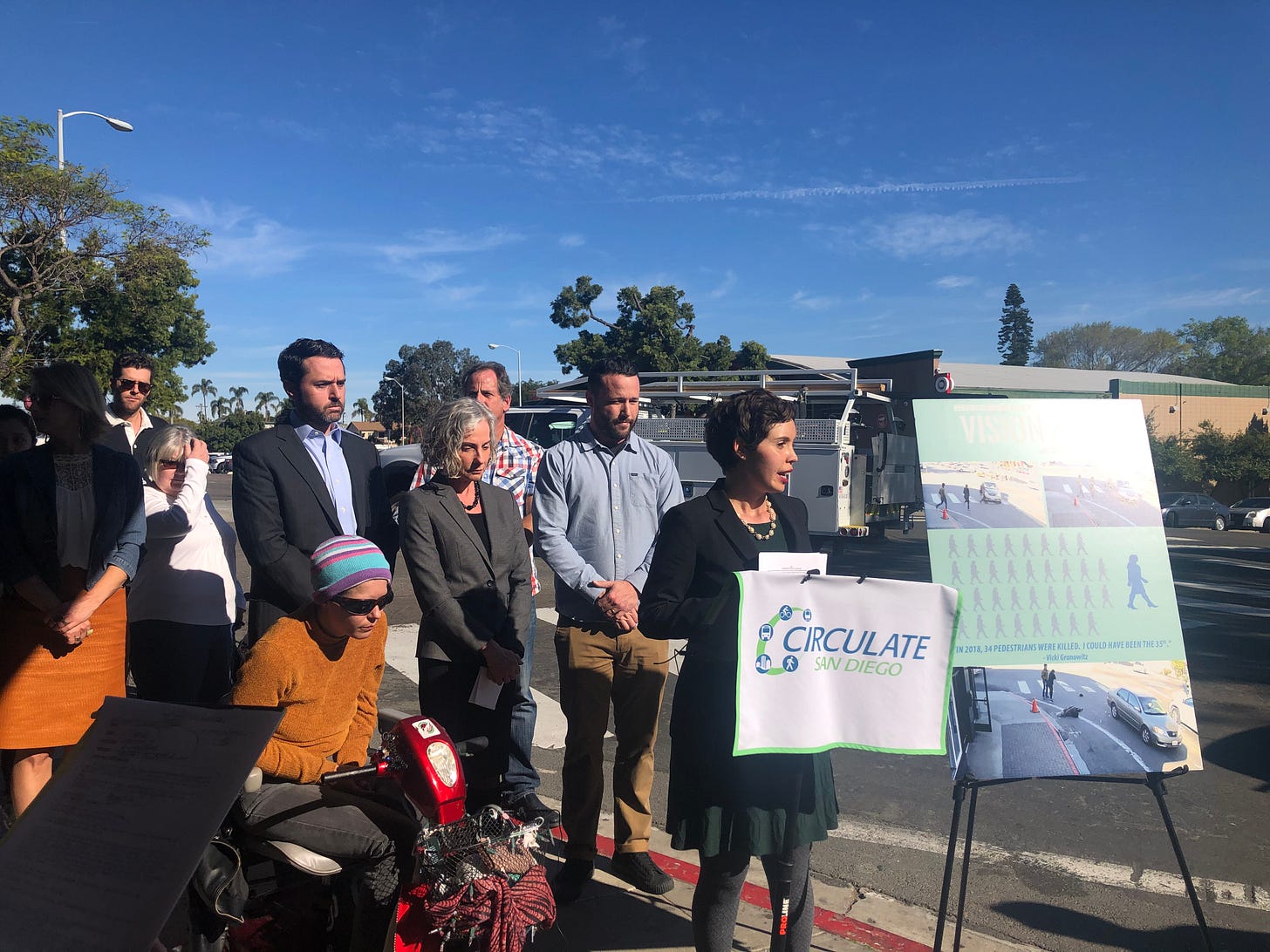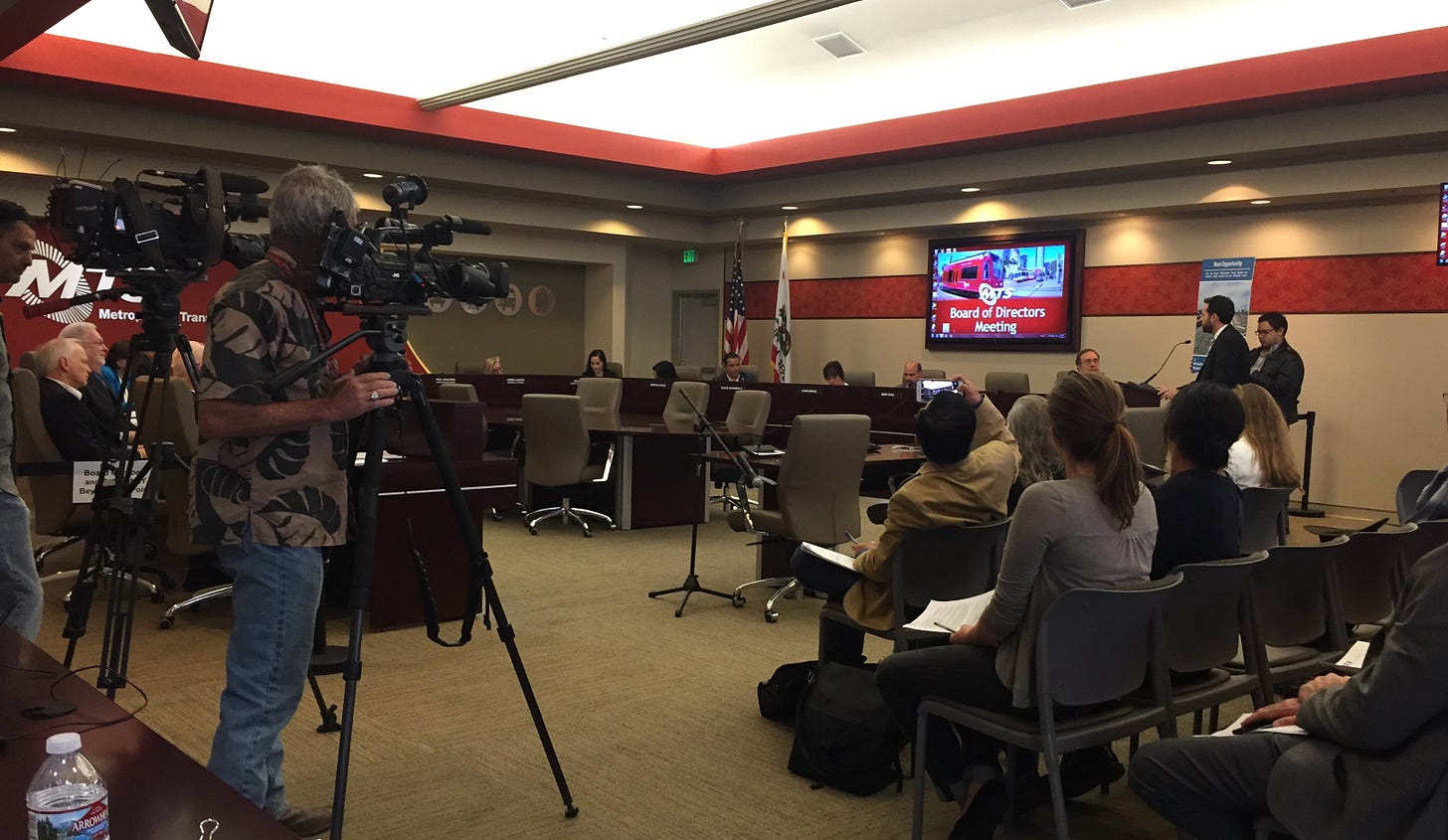Circulate San Diego’s Advocacy Model
How a small organization makes big change, and how you can too.
In this post, I am sharing Circulate San Diego’s advocacy model to help other advocates be the most effective that they can be.
At Circulate San Diego, we have had some incredible successes, far larger than one should expect from a small nine-person organization. Our campaigns are often to advance an abundance agenda. Our efforts have led to thousands of affordable homes being developed on transit agency land. We drafted and sponsored Assembly Bill 2345 and Assembly Bill 1287, the most impactful housing production bills signed by the Governor Newsom in 2020 and 2023.
We have an advocacy model that allows us to effectively apply pressure to decisionmakers with our relatively few resources.
Circulate’s Advocacy Model
Circulate’s Advocacy Model consists of four parts:
· Step 1: Identify a problem.
· Step 2: Propose a solution.
· Step 3: Repeatedly remind the public who is responsible for solving the problem.
· Step 4: Thank and recognize the decisionmakers who solve the problem.
Our model did not arise fully developed. It was the result of some trial and error, learning from peers, and applying some research and theory. In large part, it is a combination of Saul Alinsky’s “Rules for Radicals,” and a presentation from Nick Sifuentes about the Riders Alliance advocacy model, given at a 2017 TransitCenter convening. I plan to share more details about the origin of our model in a later post.
Step 1: Identify a problem.
At Circulate, we often identify a problem through one of our detailed policy reports or letters.
In some ways, identifying a problem is the easy part. It is not hard to notice when housing is unaffordable, or the bus does not get you where you need to go. Sometimes the problems are more latent.
Over the years we published a variety of independent research to show where traffic crashes are the most frequent (data shows that certain intersections are far more dangerous than others). And we surveyed transit parking lots to evaluate their utilization (some lots are empty almost always–a huge waste of public resources.)
A key part of this strategy is not to surprise the agency you critique. It is fair game to publish a criticism of a public agency. But they are far more likely to respond productively if they do not feel sandbagged.
In earlier periods, we have not always done this. In some sense, we misapplied Sun Tzu and preferred to catch people off guard. Now our regular practice is to meet with an agency before we publish something, and even invite their feedback on a draft report before publication. The conversations are sometimes tense, but the policy outcomes are often better.
Step 2: Propose a solution.
Like with identifying a problem, our research reports and policy letters are frequent tools to propose solutions.
Our favorite tactic is to canvas other peer regions, and show how they are solving the problem we identified. Many decisionmakers are risk-averse, and showing that they will not be the first to try a certain policy can be reassuring.
We had success showing how most large transit agencies in California had already adopted similar policies to develop their empty parking lots. For our transit system, we showed decisionmakers that San Diego was alone to not allow customers to store money on their transit passes.
Some effective advocacy organizations skip this step. They put the burden on the agency for devising a way to solve the problem they identify. I think this is a fine strategy for a lot of organizations.
Circulate has the expertise (and perhaps self-regard!) to go a step further and provide detailed wonky research about policy solutions. The purpose of our recommendations is to show that the problem is solvable, not to be overly committed to our proposed recommendations. This is why we often rely on showing how other regions have resolved similar challenges, as opposed to recommending our own novel solutions.
Sometimes a public agency can devise a different but effective solution. Advocates should be satisfied if a decisionmaker solves the problem, even if they do so differently than we proposed.
Step 3: Repeatedly remind the public who is responsible for solving the problem.
Almost always, the decisionmaker we identify as responsible for solving a problem is one or more elected officials. When we advocate for a policy change at a transit agency, we address letters the board chair who is an elected official, not the CEO. When we advocated for the Airport Authority to fund a transit connection, we setup a system for supporters to send hundreds of emails to the Mayor of San Diego, who appoints the plurality of the board members. Generally, it is easier to pressure an executive like a Mayor, since boards or City Councils can more easily diffuse responsibility and accountability between them.
Agency staff are generally safe in their jobs, no matter what advocates say on Twitter. Elected officials on the other hand are vulnerable to public pressure.
Sending a letter, or publishing a report is only the first step. Keeping an issue in the press over multiple news cycles makes elected officials feel uncomfortable, creating pressure for them to act.
This is not about burning bridges or making enemies. Quite the contrary, as we are unfailingly polite. Instead, what we try to establish is something we call a “useful tension.” The tension is useful because it leads to them act.
The most challenging part of this strategy is to keep an issue in the press over multiple news cycles. Our report releases are reliable tools to generate day-of coverage. Pressure tends to fade if media coverage is viewed as one-off. The challenge for the advocate is to come up with novel and newsworthy ways to attract attention, so your issue continues to generate coverage.
The modern information environment offers some additional tools. Advocates can generate public pressure with email campaigns, online petitions, and other methods to rally the public even if your issue does not make it on the nightly news.
Step 4: Thank and recognize the decisionmakers who solve the problem.
Decisionmakers who make the right decision need to be credited for that decision. They need to experience a positive benefit for changing their policy or course of action.
There is a tendency among advocates to have negative feelings about the elected officials who are the subjects of their advocacy. This is natural, given that the advocate thinks that the decisionmaker is doing something unwise or even unjust. When that decisionmaker makes a change, it can be tempting treat that as an admission that the decisionmaker was wrong all along, or proof that they are a bad person.
Effective advocates cannot indulge in that. Instead we need to thank the decisionmaker, and publicly credit them for doing the right thing.
This is especially important for repeat players. If the elected decisionmaker believes they will be bashed in the press whether or not they do the right thing, then they have little incentive to change course.
One way for an advocate to credibly communicate that there is a light at the end of the tunnel, is to show through past actions that doing the right thing comes with rewards.
The application of our model has resulted in quite a few policy wins for mobility and affordability. Hopefully other advocates can learn and borrow from our model, and achieve their own victories.







